Yesterday was Garden Bloggers’ Bloom Day. The 15th of the month is when garden bloggers from around the world post photos of what is blooming in their garden. (Thanks to Carol at May Dreams Gardens for hosting this meme.) I haven’t been doing this, and I’m not sure I will in the future. But I can’t resist showing off one particular bloom at Glen Villa, my garden in rural Quebec.
The flower I’m showcasing is Nepeta recemosa ‘Walker’s Low.’ It’s a cliché to say that a plant is blooming its heart out, but it’s true for this one. I planted the Nepeta, also known as catmint, at the Aqueduct just over a year ago. In that short time it has gone from tiny…
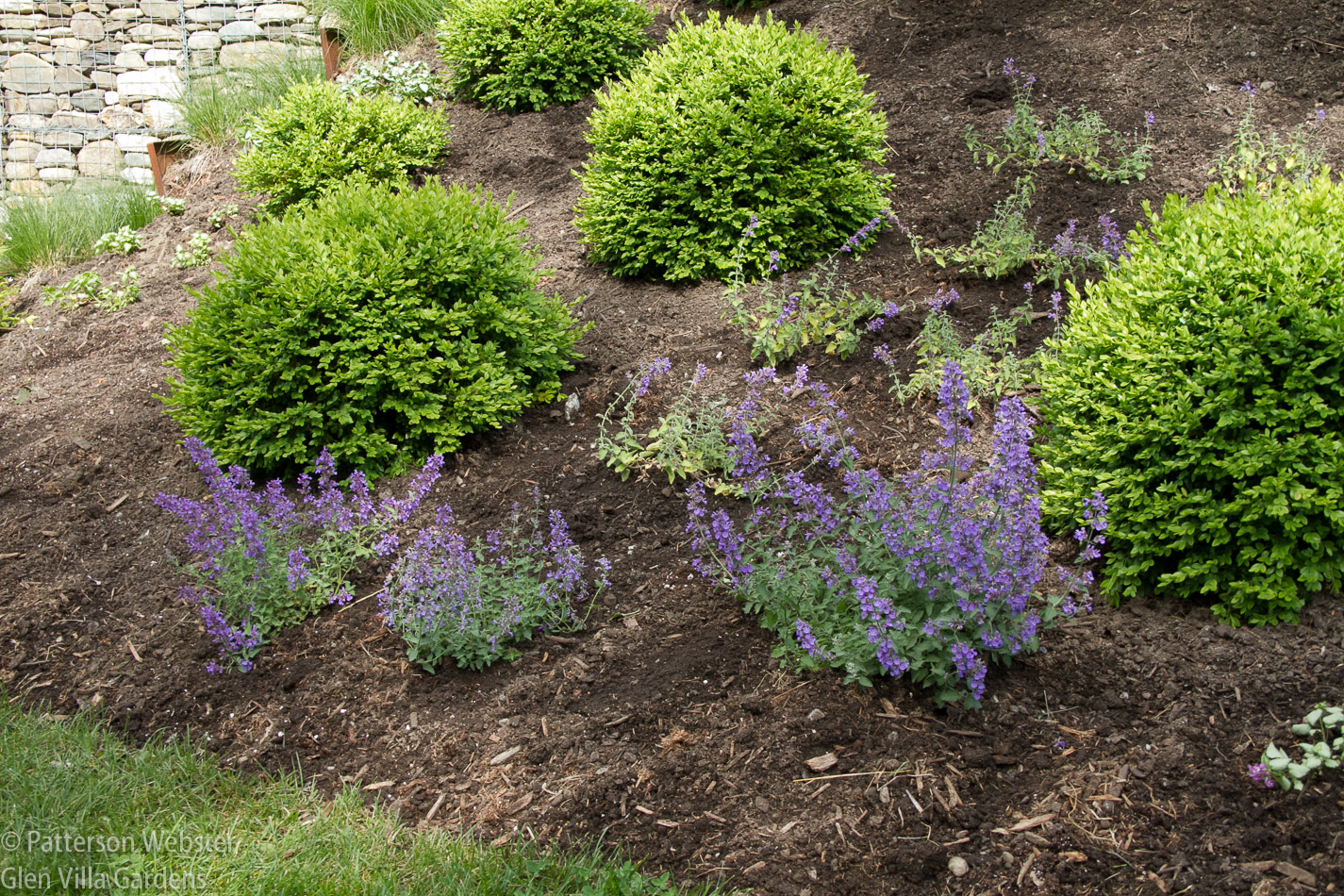
These are the plants I planted last June. They weren’t tiny but they weren’t big either.
… to tremendous.
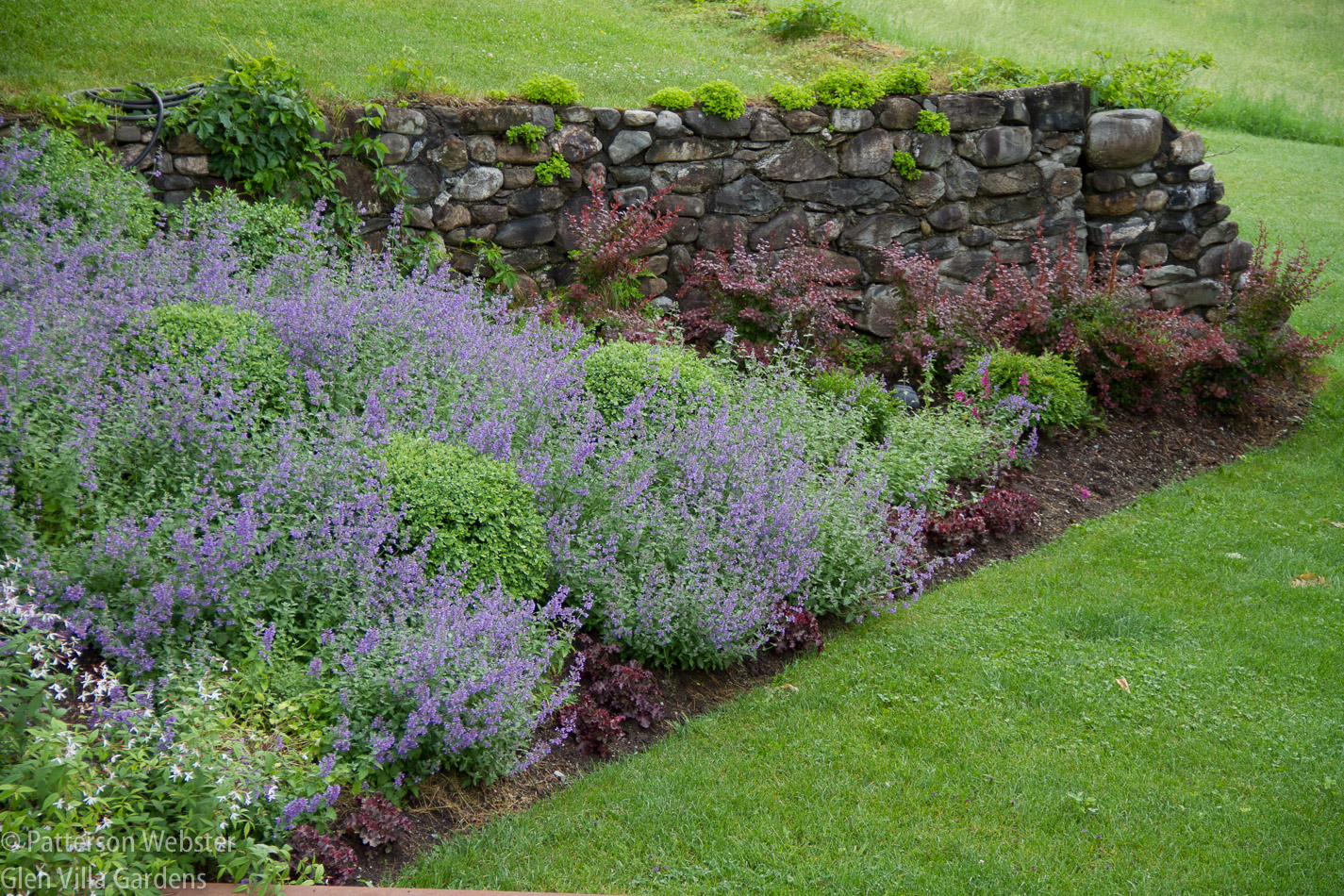
This photo is from July 15, 2017. You can barely see the Heuchera ‘Melting Fire’ I added at the front.
What astounds me as well is the length of time the catmint has been blooming. On June 4 I returned to North Hatley after three weeks in England. Everything then was looking rather forlorn, particularly in comparison with the lush gardens I’d been seeing. Regardless, I took a photo of the Aqueduct that night.
As you can see, the ground around the Nepeta was bare and the plants themselves were still quite small.
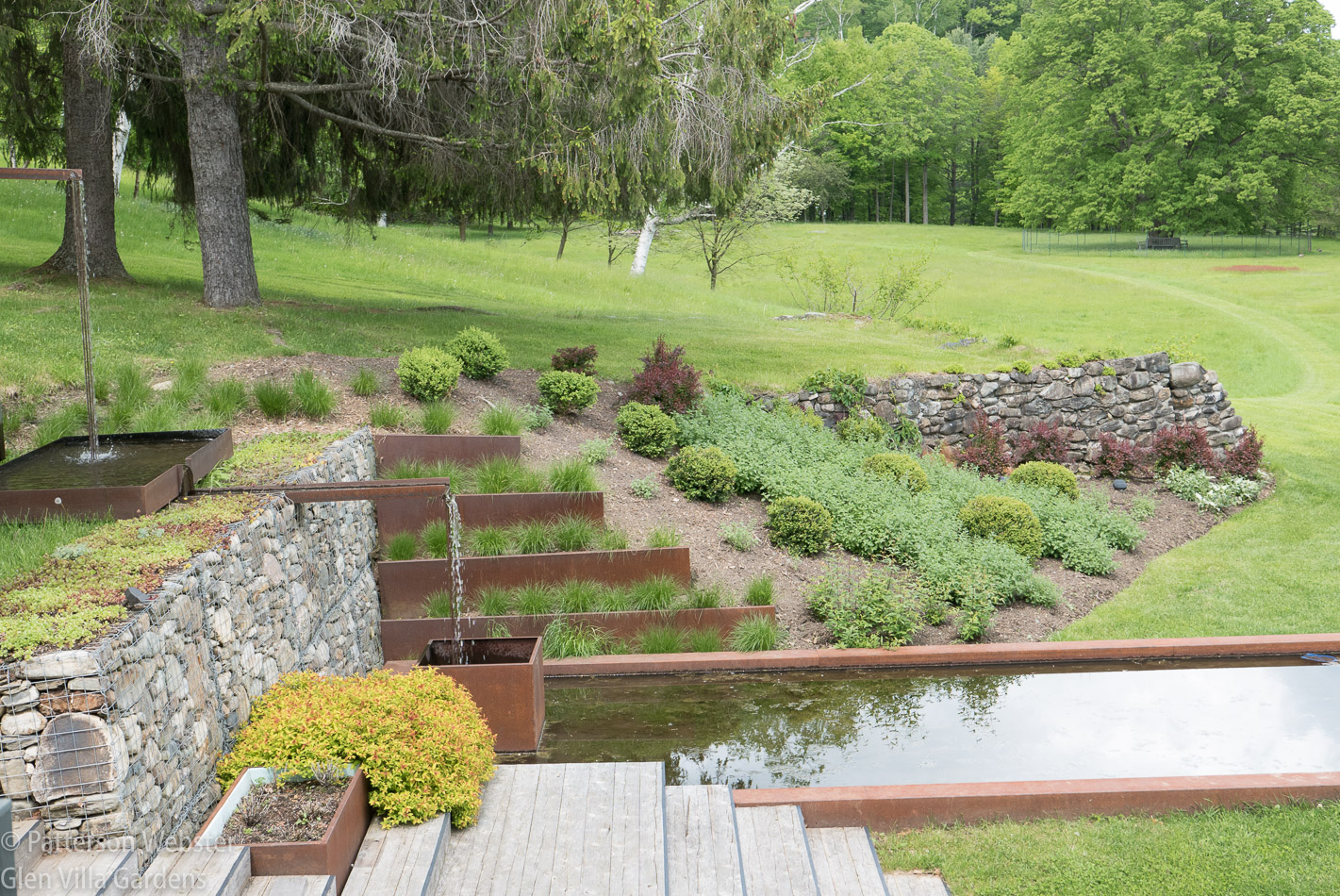
This view from June 4 shows the grass path that cuts through the Big Meadow, along with a patch of red near the linden tree. The red is dock; I’m encouraging it to spread.
A week later, things were starting to change. The flowers weren’t yet in bloom but the plants themselves had grown substantially and buds were about to break.
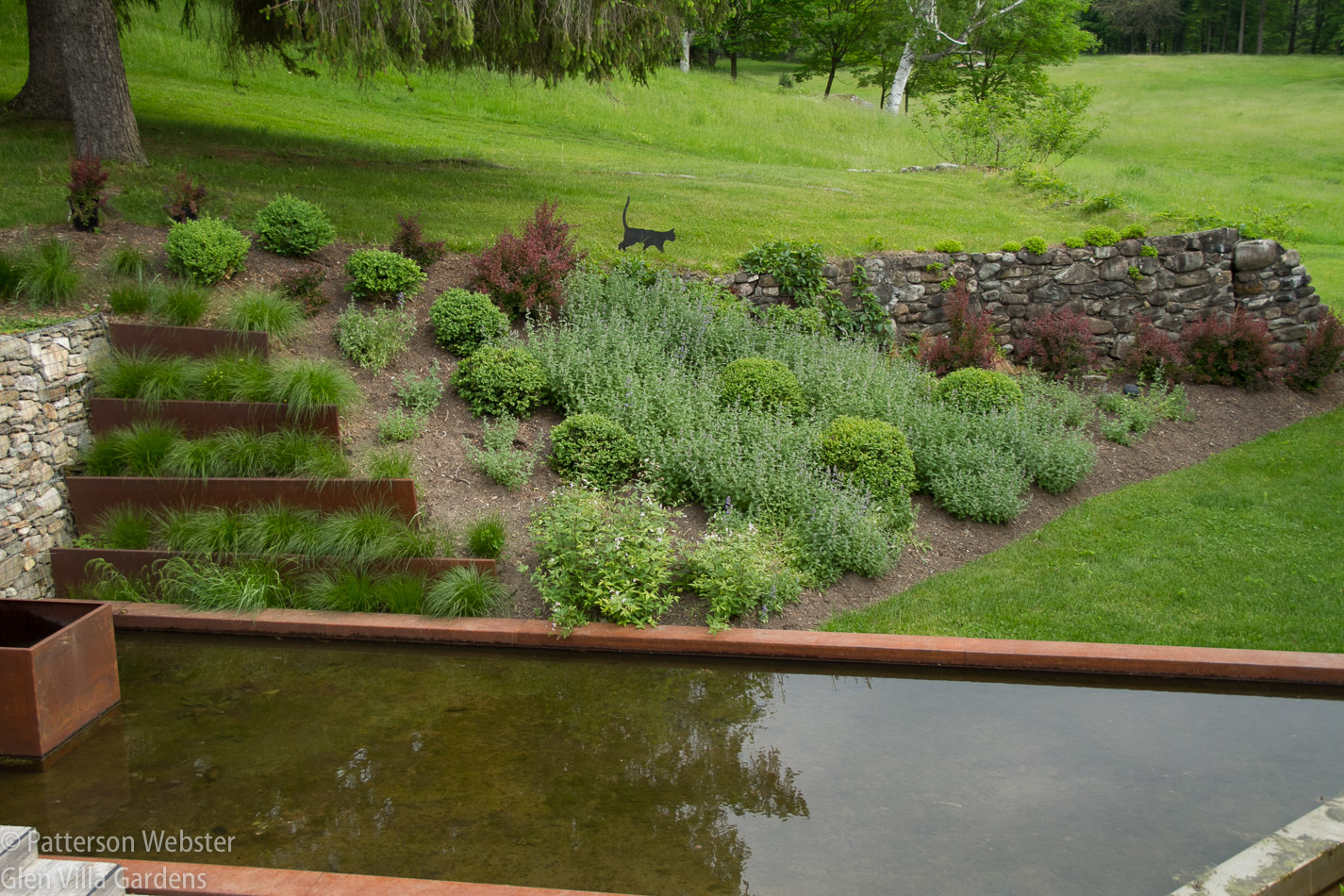
This photo dates from June 10, 2017.
Ten days later, on June 20, the flowers were in full bloom, and had been for almost a week.
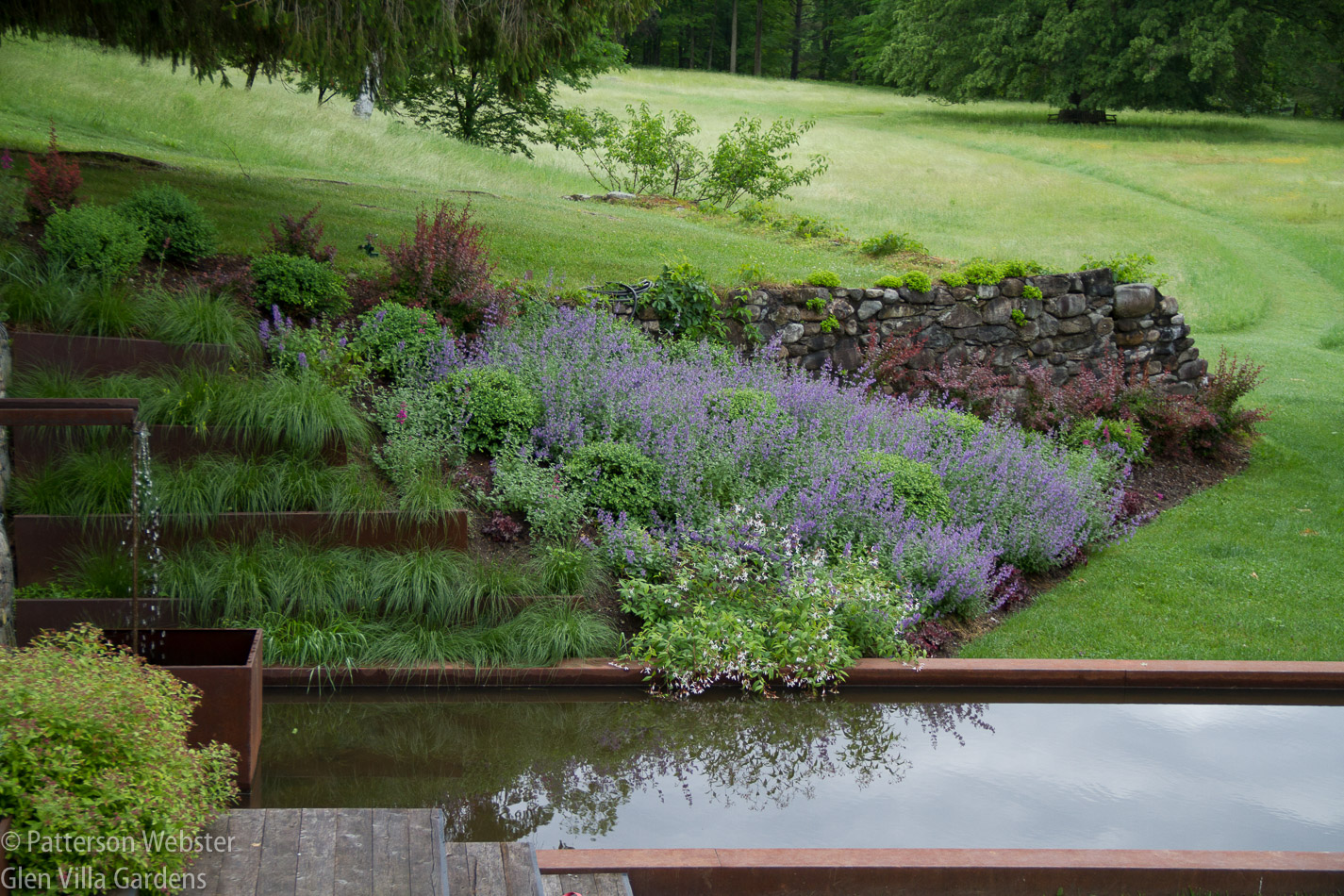
The nepeta is sprawling. At the front is Porteranthus, which used to be called Gillenia trifoliata.
A month later, the flowers are still in full bloom.
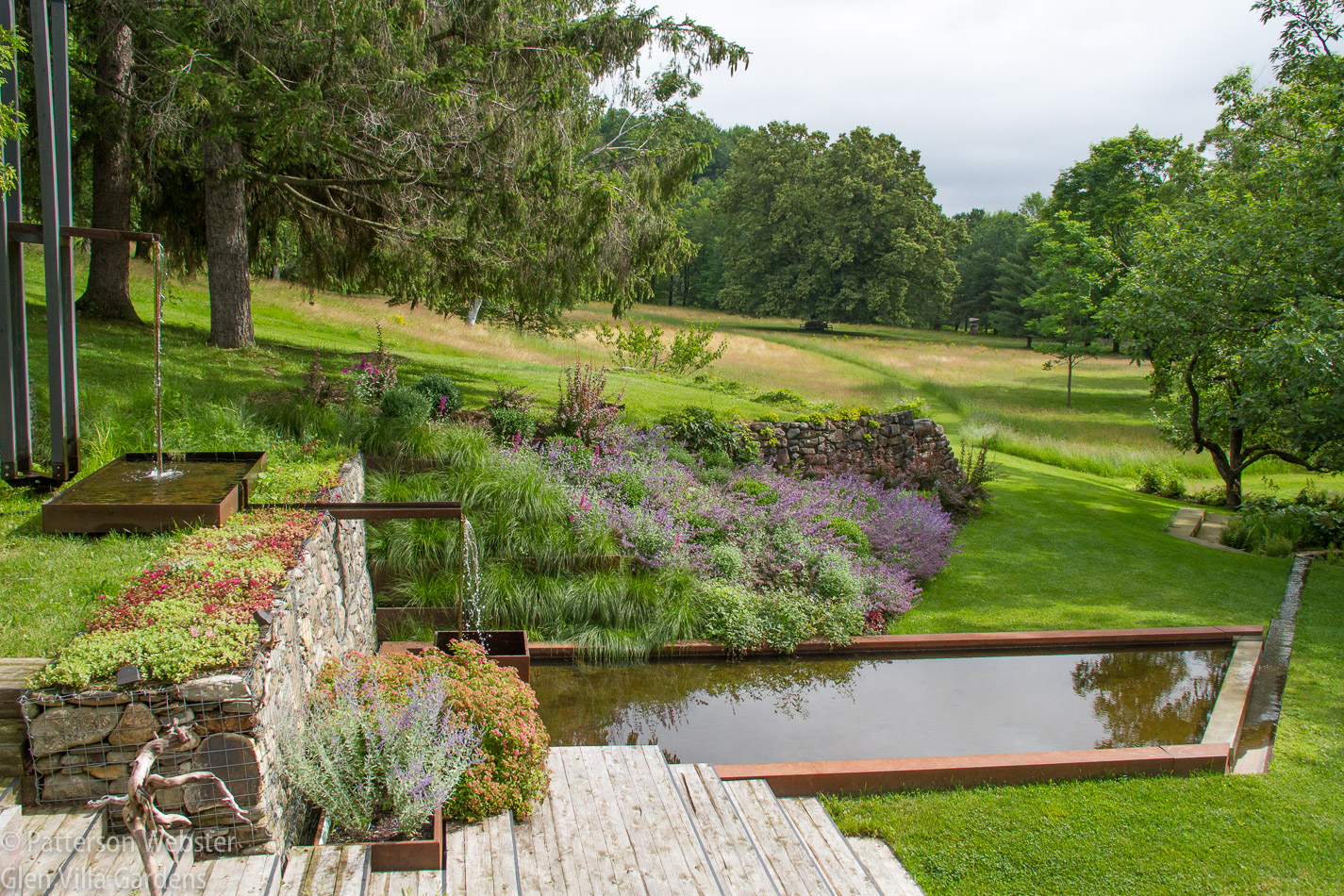
Looking beyond the nepeta you can see how the Big Meadow has grown since early June.
While I’m delighted with the Nepeta, I’m still fiddling with the other plants in the area. The boxwood and the ornamental grass (Sporobolus heterolepis or prairie dropseed) have been there for several years but the carpet of juniper I used originally fell victim to voracious deer. (Despite what the books say, the deer loved it.) So last year, along with the Nepeta, I planted a waterfall of Lamium maculatum ‘White Nancy.’ I thought the colour of the foliage and the way it spilled down the hill would echo how the water in the Aqueduct fell from pool to pool. I planted some Barberry ‘Ruby Carousel’ near the stone wall to pick up on the colour of the rusted steel, and added a froth of Porteranthus (formerly called Gillenia trifoliata) next to the reflecting pool.

This photo from June 2016 shows the Lamium and Porteranthus I added last summer. The sedum on top of the gabion wall was part of the original planting and continues to act like a multi-coloured carpet.
At the end of the summer it was clear I had to make a choice. The Nepeta was growing well, the Lamium was ok and both were overpowered visually by the prairie dropseed beside them.
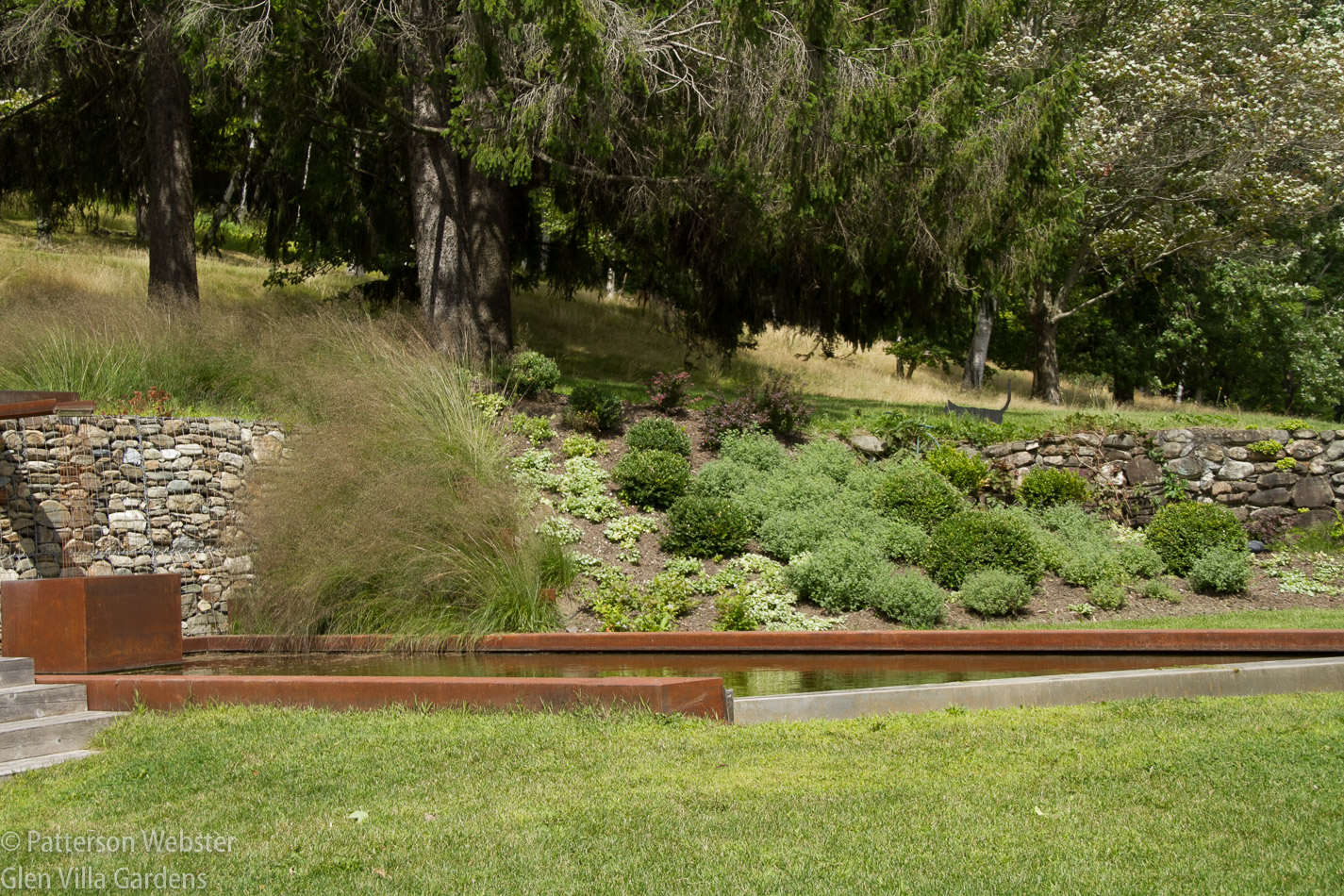
This photo from the end of August last year shows how much the plants grew over the summer.
I knew I wanted to keep the dropseed — its autumn colour is spectacular. But its bulk made the lamium beside it look small and insignificant, and that threw the whole design out of balance.
We transplanted the lamium last fall and it is much happier in its new home in a shady spot, where the speckled foliage adds a touch of light. (And because it is happier, so am I.) I left the Porteranthus in place, not sure where to move it. And after seeing it bloom this year, I’m glad I did — it’s going to stay right where it is.

The Porteranthus looks like it is bending over to take a sip of water. I may add another clump of it at the far right.
What I’m still searching for is an exclamation mark plant. I want a tall straight flower to pop up at irregular intervals, providing a strong vertical in contrast with the domed forms of the boxwood and catmint. Its colour has to work well with the blue tones of the Nepeta and the rusty orange-red of the steel. As a trial I added two varieties of giant hyssop this year, Agastache ‘Bolero’ and ‘Heatwave’, but neither offers enough contrast, in colour or form.
So now I’m looking for a replacement. I’ve ordered bulbs of Eremurus ‘Cleopatra’ but I’m worried that they will bloom too early and for too short a time. And I’m not convinced that Eremurus will be reliably hardy in our area. Foxglove might be a good choice, or one of the newer cultivars of Baptisia. I’m really not sure.
What do you think? Am I overlooking an obvious choice? Advice, please!
Open Garden Day
The Open Garden Day at Glen Villa is your chance to support the Massawippi Conservation Trust and the public trails it is building through beautiful natural woodland.
Saturday, July 29
10-4
1020 chemin de North Hatley
Sainte Catherine de Hatley, QC
Your $25 admission fee, payable at Glen Villa, goes directly to the Trust. Reservations through the Massawippi Foundation’s website are advisable but not essential.







For your exclamation mark – especially in the blue clouds of nepeta — may I suggest ‘Flamenco’ kniphofia? It’s just finished blooming in my garden, though the ‘Walker’s Low’ has gone on and on. (I suspect it loves our cool, rainy early summer). Or you could get two types of kniphofia with staggered bloom, but make sure they’re both orange.
Great suggestion, Janet. I’ve checked several websites. At 18″-24″‘Flamenco’ isn’t tall enough. But Echo Rojo at 39″-51″ is — if Perennials.com is to be believed. Monrovia lists both as shorter. Winter would prove difficult too but the colour and form are ideal so they may be worth trying.
I have no plant advice for you, but I love the overall design of the steel waterfall and reflecting pool and tiered beds alongside. And I think it’s a testament to catmint’s garden-worthiness to note that it also performs well in Austin’s heat and drought provided it’s given some shade. It blooms better here in spring and fall than summer, but that’s true for most of our perennials. Pam/Digging: penick.net
Interesting to know how versatile catmint is. Is it used much in Texas? I don’t remember seeing a lot of it until a few years ago — and now I’m seeing it more and more.
what about Perovskia or Verbena bonariensis (is it hardy where you are?)
I have Perovskia growing in a planter almost next to the nepeta. I love it, and Verbena bonariensis. The Verbena is an annual for me, and neither it or the perovskia offer enough contrast in colour. But thank you for making the suggestions.
What about Perovskia or Verbena bonariensis (may not be hardy but for me it seeds liberally)
Love your Aqueduct planting and the Gabon stone wall. As for a suggestion, what about a Verbascum?
I think they really look like an exclamation point!
Verbascum does look like an exclamation mark, I agree. The one thing I failed to mention is height. The nepeta mounds are 30″ at least so to make a statement the exclamation has to rise above them. ideally, I’ll find a plant that is the right shape (basal leaves would be ideal), the right colour (orange or something tending in that direction) and the right height. I think of Verbascum as being shorter. But your suggestion has made me think of mullein. I’ll do some research on both.
All looking good and now time to enjoy!
Never time simply to enjoy…. what a thought!
I also have Nepeta ‘Walker’s Low’ which I nickname “catnest” because local cats like to roost in the middle of it. Even in my part-shade garden, it blooms its heart out. I never have the heart, myself, to give it a shearing back to keep it compact because it means sacrificing blooms. I’m wimpy that way.
Someone has suggested Knipofia as your exclamation mark. It tends to be more rigid than Baptisia – the latter can sprawl just as much as the Nepeta once it gets a good clump going. You’ve probably already spurned the idea of a grass like Calamagrostis. Not all that colour-contrasty, but it does tend to stay upright. Or how about lilies? Or Veronicastrum – too wispy?
By the way, you might want to double-check on the nomenclature for Porteranthus. I think it’s back to Gillenia now.
I can’t bring myself to cut it back, either, Helen. I’d love to use Knipofia — it really is the look I’m going for — tall, straight and orangey — but it isn’t tall enough. I hadn’t thought of lilies. I’m sure I could find a good colour but not convinced that the form is right. But definitely worth trying.
Nomenclature: yuck! Thanks for the heads up. (And I hope you are right, I like Gillenia — it sounds nicer.
How about Ironweed (Vernonia) or Joe Pye Weed?
I love Joe Pye weed and it grows wild all around us. The only Vernonia I’m familiar with has small dark purple blossoms. I’m looking for something with more colour contrast — an orange tone. Since you are an orange lover, does anything else occur to you? It needs to be a minimum of three feet, preferably four.
The only orange I can think of is the annual Tithonia rotundifolia (Mexican Sunflower). You would have to germinate them indoors then transplant. Unless you want to go with Helenium – maybe there is a variety that is tall enough. Otherwise everything I can think of would be yellow.
I’m not prepared to germinate and transplant… even though Tithonia would be a great choice. I’m thinking of putting little mounds of earth in place, then planting kniphofia or Helenium on that (I’m not serious… but I wonder if that would work.)
How have I missed bloom day until now? Thanks for that. You were right about the balance being wrong – I can’t especially help but I love such discussions online and think they must help us all ‘see’ better, looking critically at someone else’s planting and thinking about what it needs. Good stuff. Xxxx
Bloom day has set me thinking about longer views and balance. I’m still searching for the perfect exclamation mark but I’ve had many great suggestions.
The more I look the more I think – no exclamation mark (!) This may be because British bedding always used to have such ‘dot’ plants sticking up in them. But I think you’re nearly there without that addition. What is missing that makes you want them?
I want more colour contrast and contrast in height. Perhaps when the boxwood get bigger, they will stand out enough… but with our short season and consequent slow growth, that could be five or six years. I don’t have time to waste!
If I’m “nearly there,” what do you think is missing?
Not altogether sure – remember, you can see it in the flesh, I only have a picture. But I like the flatness, just mildy broken by the round box lumps and I like its low keyness – so I’d look for subtle colour addition. Something intermingling in white, also small flowered maybe? If you let me know why that wouldn’t work for you, that might be illuminating for me. Xxx
Have you thought about coneflowers? Lurie Garden has an amazing mix of nepeta, hyssop and coneflowers that I find breathtaking. I love those blue/lavenders.
No, coneflower hadn’t occurred to me and thanks for the idea. Mine are coming into bloom now, just as the nepeta is fading. That might be a good thing… continuing bloom.
Rudbeckia maxima? Plus Verbena bonariensis? The big meadow looks wonderful.
Verbena bonariensis would work really well, I think… but I’d have to plant it annually. Might be worth it.